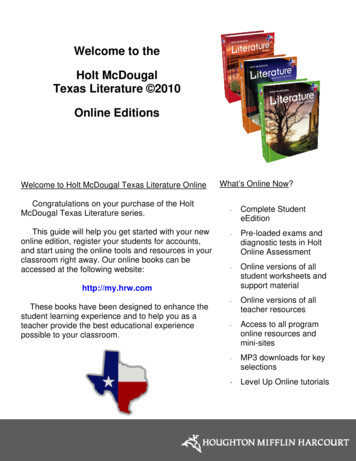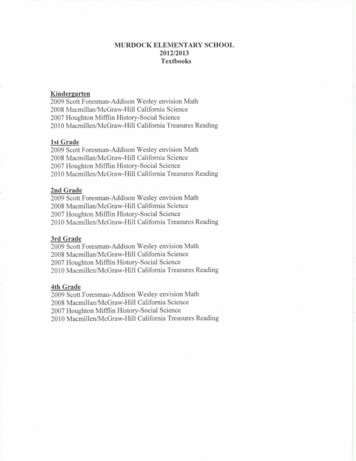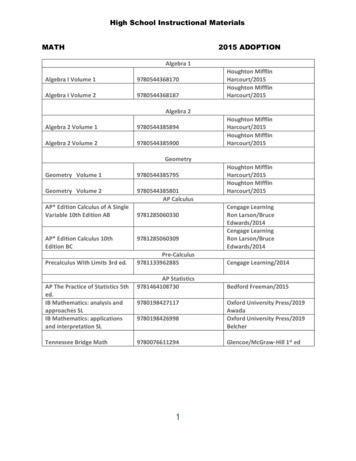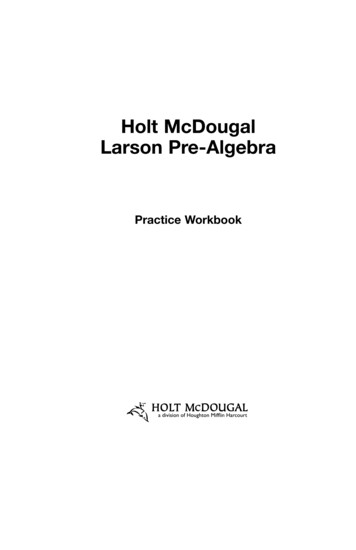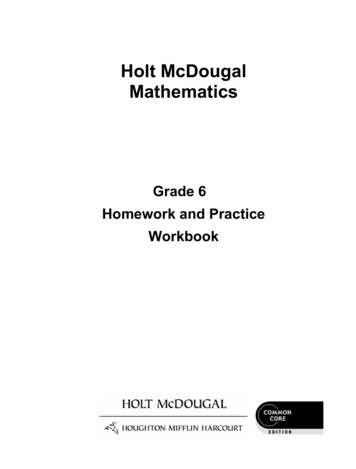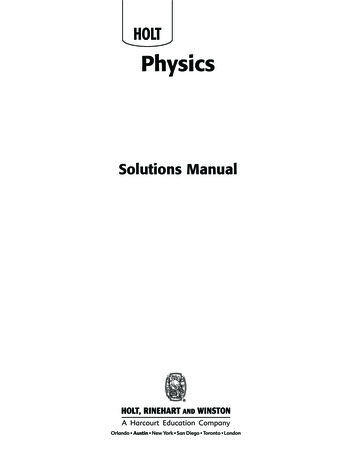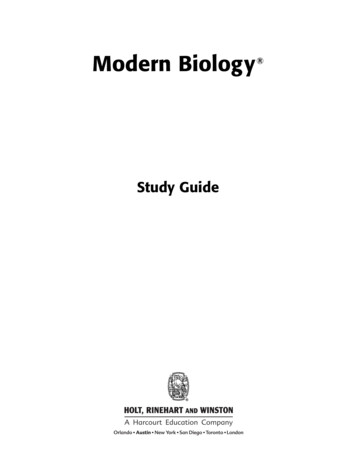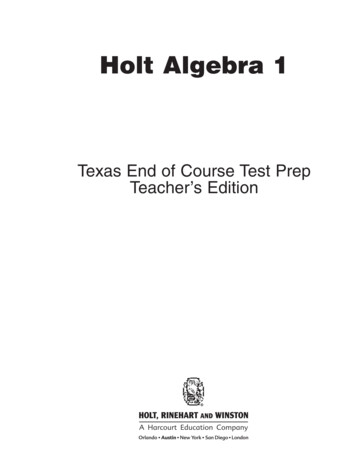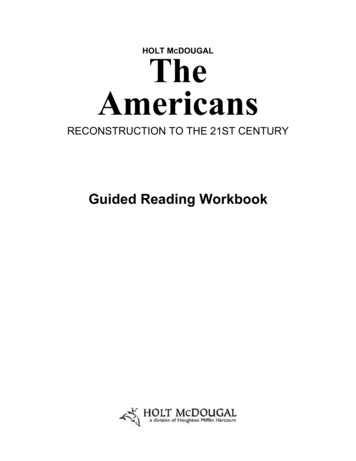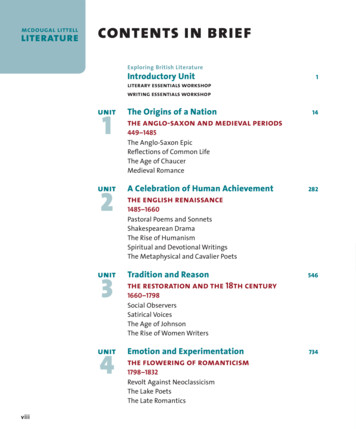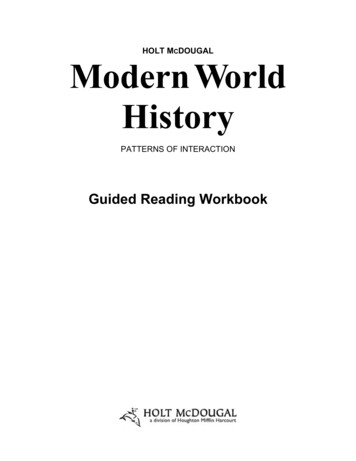
Transcription
HOLT MCDOUGALModern WorldHistoryPATTERNS OF INTERACTIONGuided Reading Workbook
Copyright by Houghton Mifflin Harcourt Publishing CompanyAll rights reserved. No part of this work may be reproduced or transmitted in any form or byany means, electronic or mechanical, including photocopying or recording, or by anyinformation storage or retrieval system, without the prior written permission of the copyrightowner unless such copying is expressly permitted by federal copyright law.Permission is hereby granted to individuals using the corresponding student's textbook or kitas the major vehicle for regular classroom instruction to photocopy entire pages from thispublication in classroom quantities for instructional use and not for resale. Requests forinformation on other matters regarding duplication of this work should be addressed toHoughton Mifflin Harcourt Publishing Company, Attn: Contracts, Copyrights, and Licensing,9400 South Park Center Loop, Orlando, Florida 32819.Printed in the U.S.A.ISBN 978-0-547-52082-7123456789 XXX16 15 14 13 12 11 10450000000000 B C D E F GIf you have received these materials as examination copies free of charge, HoughtonMifflin Harcourt Publishing Company retains title to the materials and they may not beresold. Resale of examination copies is strictly prohibited.Possession of this publication in print format does not entitle users to convert thispublication, or any portion of it, into electronic format.
ContentsBeing a Strategic Reader . vPrologue The Rise of DemocraticIdeasSection 1. 1Section 2. 5Section 3. 9Section 4. 13Chapter 7 The French Revolutionand Napoleon, 1789–1815Section 1 . 86Section 2 . 89Section 3 . 92Section 4 . 95Section 5 . 98Chapter 1 European Renaissanceand Reformation, 1300–1600Section 1. 17Section 2. 20Section 3. 23Section 4. 26Chapter 8 Nationalist RevolutionsSweep the West, 1789–1900Section 1 . 101Section 2 . 104Section 3 . 107Section 4 . 110Chapter 2 The Muslim WorldExpands, 1300–1700Section 1. 29Section 2. 32Section 3. 35Chapter 9 The Industrial Revolution1700–1900Section 1 . 113Section 2 . 116Section 3 . 119Section 4 . 122Chapter 3 An Age of Explorationsand Isolation, 1400–1800Section 1. 38Section 2. 41Section 3. 44Chapter 10 An Age of Democracyand Progress, 1815–1914Section 1 . 125Section 2 . 128Section 3 . 131Section 4 . 134Chapter 4 The Atlantic World,1492–1800Section 1. 47Section 2. 50Section 3. 53Section 4. 56Chapter 11 The Age of Imperialism,1850–1914Section 1 . 137Section 2 . 140Section 3 . 143Section 4 . 146Section 5 . 149Chapter 5 Absolute Monarchs inEurope, 1500–1800Section 1. 59Section 2. 62Section 3. 65Section 4. 68Section 5. 71Chapter 12 Transformations Aroundthe Globe, 1800–1914Section 1 . 152Section 2 . 155Section 3 . 158Section 4 . 161Chapter 6 Enlightenment andRevolution, 1550–1789Section 1. 74Section 2. 77Section 3. 80Section 4. 83Chapter 13 The Great War, 1914–1918Section 1 . 164Section 2 . 167Section 3 . 170Section 4 . 173Original content Houghton Mifflin Harcourt Publishing Company. Additions and changes to the original content are the responsibility of the instructor.iiiGuided Reading Workbook
ContentscontinuedChapter 14 Revolution andNationalism, 1900–1939Section 1. 176Section 2. 179Section 3. 182Section 4. 185Chapter 15 Years of Crisis, 1919–1939Section 1. 188Section 2. 191Section 3. 194Section 4. 197Chapter 16 World War II, 1939–1945Section 1. 200Section 2. 203Section 3. 206Section 4. 209Section 5. 212Chapter 17 Restructuring thePostwar World, 1945–PresentSection 1. 215Section 2. 218Section 3. 221Section 4. 224Section 5. 227Chapter 18 The Colonies BecomeNew Nations, 1945–PresentSection 1. 230Section 2. 233Section 3. 236Section 4. 239Section 5. 242Chapter 19 Struggles for Democracy,1945–PresentSection 1. 245Section 2. 248Section 3. 251Section 4. 254Section 5. 257Chapter 20 Global Interdependence,1960–PresentSection 1. 260Section 2. 263Section 3. 266Section 4. 269Section 5. 272Original content Houghton Mifflin Harcourt Publishing Company. Additions and changes to the original content are the responsibility of the instructor.ivGuided Reading Workbook
Being a Strategic ReaderHow to Use This BookThe purpose of this Guided Reading Workbook is to help you read andunderstand your history textbook, Modern World History: Patterns ofInteraction. You can use this Guided Reading Workbook in two ways.1. Use the Guided Reading Workbookside-by-side with your history book.Strategy: Read the Termsand Names and the definitionof each. The Terms andNames are in dark type in thesection. Turn to the section that you aregoing to read in the textbook.Then, next to the book, putthe pages from the GuidedReading Workbook thataccompany that section. Allof the heads in the GuidedReading Workbook matchthe heads in the textbook. Use the Guided ReadingWorkbook to help you readand organize theinformation in the textbook.2. Use the Guided ReadingWorkbook to study thematerial that will appearin the chapter tests. Reread the summary ofevery chapter. Review the definitions ofthe Terms and Names inthe Guided ReadingWorkbook. Review the graphicorganizer that youcreated as you readthe summaries. Review your answersto questions.Strategy: Use a graphicorganizer to help youorganize information in thesection.Strategy: Read thesummary. It contains themain ideas and the keyinformation under the head.Original content Houghton Mifflin Harcourt Publishing Company. Additions and changes to the original content are the responsibility of the instructor.vGuided Reading Workbook
Being a Strategic ReadercontinuedStrategy: Underline the mainideas and key information asyou read.Strategy: Answer thequestion at the end of eachpart.Original content Houghton Mifflin Harcourt Publishing Company. Additions and changes to the original content are the responsibility of the instructor.viGuided Reading Workbook
Being a Strategic ReadercontinuedThe last page of each section of the Guided Reading Workbook ends with agraphic organizer that will help you better understand the information inthe section. Use the graphic organizer to take notes as you read. The notescan help you to prepare for the section quiz and chapter tests.Original content Houghton Mifflin Harcourt Publishing Company. Additions and changes to the original content are the responsibility of the instructor.viiGuided Reading Workbook
Name Class DateThe Rise of Democratic IdeasSection 1The Legacy of Ancient Greeceand RomeTerms and Namesgovernment System for exercising authoritymonarchy Government controlled by one personaristocracy State ruled by the noble classoligarchy A government ruled by a few powerful peopledemocracy Idea that people can govern themselvesdirect democracy Government in which citizens rule directly and not throughrepresentativesrepublic Government in which citizens elect the leaders who make governmentdecisionsSenate Aristocratic branch of Rome’s governmentBefore You ReadIn this section, you will learn how democracy started in Greece andRome.As You ReadUse a web diagram to record the contributions of Greece and Rome todemocracy.ATHENS BUILDS A LIMITEDDEMOCRACY (Pages 5–7)How did democracy develop?Throughout history, people have knownthe need for a government, or a systemfor exercising authority. For most ofhistory, people have lived under singlerulers, such as kings. This type of rule iscalled a monarchy. These rulers had totalpower. Other governments that developedincluded aristocracy, which is a stateruled by the noble class. Later as tradeexpanded, a class of wealthy merchantsoften ruled a land. This was known as anoligarchy. The idea of democracy—thatpeople can govern themselves—grewslowly. Many people contributed to thatidea over the centuries.Greek civilization began about2000 B.C. Ancient Greece was made up ofcity-states. Each city-state had its owngovernment. The first democracydeveloped in the city-state of Athens.Athens had a king at first. Then itbecame an aristocracy. Each year anassembly of citizens elected three noblesto rule Athens. Citizens were adult maleresidents given certain rights andresponsibilities.Original content Houghton Mifflin Harcourt Publishing Company. Additions and changes to the original content are the responsibility of the instructor.1Guided Reading Workbook
Name Class DateSection 1, continuedA statesman called Solon created fournew kinds of citizenship in the sixthcentury B.C. All free adult males werecitizens. All citizens were able to vote inthe assembly. But only citizens of thethree higher classes could hold publicoffice.Democracy in Athens was limited. Onlyabout one-tenth of the population werecitizens. Women, slaves, and foreignresidents could not be citizens. Slavesmade up about one-third of the Athenianpopulation at that time.About a hundred years after Solon, aleader named Cleisthenes increased thepower of the assembly. He allowed allcitizens to present laws for debate andpassage. He also created a council whosemembers were chosen by lot, or atrandom. The council suggested laws andadvised the assembly.defeated by armies from the kingdom ofMacedonia. This defeat ended democracyin Greece.During this troubled time, severalphilosophers appeared. Socrates, Plato,and Aristotle set forth their ideas ongovernment and society.Greek ideas had lasting influence ongovernment and philosophy. The Greeksdid not rely on traditional explanations ofthe world. Instead they used reason to findpatterns that they called natural laws. Theydeveloped direct democracy and the threebranches of government.1. How did Cleisthenes help to increasedemocracy in Athens?How was the Roman governmentorganized?Rome began to rise as Greece fell. By509 B.C., Rome was a republic. Arepublic is a form of government in whichcitizens have the right to vote and to selecttheir leaders. In Rome, as in Athens,citizenship with voting rights belongedonly to males who were not born slaves orforeigners.Rome’s republican government hadseparate branches. Two officials calledconsuls directed the government. Thelegislative branch was made up of theSenate and two assemblies. The Senatewas the aristocratic branch of government.The assemblies were more democratic.They included other classes of citizens. Intimes of trouble, the republic gave vastpowers to a ruler called a dictator.Rome gradually increased its territorythrough conquest. It then became anempire under the rule of a powerfulemperor.2. How did Pericles change democracy inAthens?ROME DEVELOPS A REPUBLIC(Page 10)GREEK DEMOCRACY CHANGES(Pages 7–9)What changes occurred in Greekdemocracy?In the fifth century B.C., armies of thePersian Empire invaded Greece. But thePersians were defeated by the Greek citystates in 479 B.C. Athens then became theleader of the city-states. A wise leader,Pericles, ruled Athens.Pericles strengthened democracy. Heincreased the number of paid publicofficials. This allowed poorer citizens toserve in government. He also introducedthe idea of direct democracy. Thisallowed citizens to participate directly ingovernment.Tensions between the city-states led tofighting among them. Then Greece wasOriginal content Houghton Mifflin Harcourt Publishing Company. Additions and changes to the original content are the responsibility of the instructor.2Guided Reading Workbook
Name Class DateSection 1, continuedIn 451 B.C., the Romans created theTwelve Tables, the first written collectionof Roman laws. They gave citizens theright to be protected by the laws. About1,000 years later, all Roman laws were puttogether in the Code of Justinian. It laterwas used as a guide on law throughoutwestern Europe. The Code established theidea of “a government of laws, not ofmen.” Under this idea, even rulers andother powerful persons could be heldaccountable for their actions.3. How was the Roman legislativebranch organized?ROMAN LAW (Page 11)Why did Romans create a system oflaws?The Romans created a system of lawsthat they could use throughout theirempire. Rome’s laws have influenceddemocracy. Some of the most importantprinciples of Roman law were: equaltreatment under the law; innocent untilproven guilty; the burden of proof restswith the accuser; and unreasonable orunfair laws could be set aside.4. Why were the Twelve Tablesimportant?Original content Houghton Mifflin Harcourt Publishing Company. Additions and changes to the original content are the responsibility of the instructor.3Guided Reading Workbook
Name Class DateSection 1, continuedAs you read this section, fill in the chart below by naming each person’scontribution to the development of democracy in ancient Greece.Greek LeaderRole in Developing Democracy1. Solon2. Cleisthenes3. PericlesUse the diagram to give examples and to explain how Roman lawsinfluenced the development of democracy.Original content Houghton Mifflin Harcourt Publishing Company. Additions and changes to the original content are the responsibility of the instructor.4Guided Reading Workbook
Name Class DateThe Rise of Democratic IdeasSection 2Judeo-Christian TraditionTerms and NamesJudaism Religion of the IsraelitesTen Commandments Written code of lawsChristianity Religion founded by JesusIslam Religion founded by MuhammadRoman Catholic Church Church that developed from ChristianityRenaissance Cultural movement that started in Italy in the 1300s and spreadthroughout EuropeReformation Religious reform movement that began in the 16th centuryBefore You ReadIn the last section, you read about the development of democracy inGreece and Rome.In this section, you will learn about the teachings of Judaism,Christianity, and Islam.As You ReadUse a chart to list one contribution to democracy from Judaism,Christianity, Islam, the Renaissance, and the Reformation.JUDAISM (Pages 12–13)What was Judaism?The Israelites were the ancient peoplewho developed Judaism. People are thechildren of God according to the HebrewBible. (The Hebrew Bible is the OldTestament in Christianity.) Unlike othergroups of people around them, Israelitesbelieved in one god. Israelites alsobelieved that God gave people the freedomto choose between good and evil.Therefore, each person was responsible forthe choices he or she made. These beliefsled to a new emphasis on the worth of theindividual.The Israelites came to be known as theJews. They developed a written code oflaw. It was called the TenCommandments. The Bible says thatGod gave these laws to Moses in about1200 B.C. These laws focused more onmorality and ethics than they did onpolitics.The Israelites believed in actingresponsibly toward others. They thoughtthat the community should help the lessfortunate. The prophets of Judaism hopedfor a world without poverty or injustice.Prophets were leaders and teachersbelieved by the Jews to be messengersfrom God.1. What were two beliefs of Judaism?Original content Houghton Mifflin Harcourt Publishing Company. Additions and changes to the original content are the responsibility of the instructor.5Guided Reading Workbook
Name Class DateSection 2, continued the worth of the individualCHRISTIANITY; ISLAM (Pages 14–15)How did Christianity and Islam start?Jesus was born during 6 to 4 B.C. At thistime, the Romans ruled Judea, thehomeland of the Jews. Jesus began topreach at the age of 30. His preachingcontained many ideas from Jewishtradition, including the TenCommandments. He also stressed theimportance of people’s love for God, theirneighbors, their enemies, and themselves.When Jesus and his teachings seemed tothreaten the power both of the Jewishpriests and the Romans, they put him todeath.In the first century after Jesus’ death,his followers started a new religion basedon his messages. It was calledChristianity. The apostle Paul wasimportant in spreading this religion. Hepreached that all human beings wereequal.The Romans opposed both Judaism andChristianity. But these religions spreadthroughout the Roman Empire. When theJews rebelled against the Romans, theywere forced from their homeland. TheJews then fled to many parts of the world.They carried their beliefs with them. AsChristianity expanded, it became apowerful religion within the empire. By380, it had become the empire’s officialreligion.Islam was another religion thatbelieved in one god. It started in southwestAsia in the early 600s. This religion, too,taught that all people were equal. It alsobelieved in the worth of the individual andthe responsibility of the community tohelp its unfortunate members.Several beliefs of these three religionshelped to shape democratic ideas. Thesebeliefs included: the equality of people before God2. How did Judaism and Christianityspread throughout the world?RENAISSANCE ANDREFORMATION (Pages 16–17)How did the Renaissance andReformation help democracy?The Roman Catholic Church was thechurch that developed from earlyChristianity. By the Middle Ages, it wasthe most powerful institution in Europe. Itinfluenced all parts of life.In the 1300s, a cultural movementcalled the Renaissance spread throughEurope. This movement led to an interestin the works of the Greeks and theRomans. Renaissance thinkers wereconcerned about earthly life. They did notthink about it as a preparation for life afterdeath. The Renaissance also focused onthe importance of the individual. Artistsfocused on capturing individual character.Explorers went out to find new lands.Merchants took many risks to gain hugewealth.The Renaissance also led people toquestion the Church. This questioningcaused the Reformation. TheReformation was a protest movementagainst the power of the Church. It startedout as a call for reform. It ended upproducing a new division of Christianity—Protestantism.The Reformation began in Germany.Martin Luther criticized the Church forselling pardons for sins. He also disagreedwith the Church in its teaching that peoplewere saved by grace and good works.Luther said people could be saved onlythrough faith in God. Soon, many newProtestant faiths sprang up. the duty of individuals and thecommunity to help oppressed peopleOriginal content Houghton Mifflin Harcourt Publishing Company. Additions and changes to the original content are the responsibility of the instructor.6Guided Reading Workbook
Name Class DateSection 2, continuedProtestant ideas strengthened the beliefin the importance of the individual. InProtestant faiths, the clergy did not havespecial powers. People could find theirown way to God. They could read andinterpret the Bible for themselves.The Reformation broke apart thereligious unity of Europe. It challenged theauthority of Catholic monarchs and popes.It contributed to the growth of democracy.3. How did the Reformation contribute tothe growth of democracy?Original content Houghton Mifflin Harcourt Publishing Company. Additions and changes to the original content are the responsibility of the instructor.7Guided Reading Workbook
Name Class DateSection 2, continuedAs you read about religious traditions and reactions to them, fill in thechart to identify the democratic ideas that arose from each.Influence on the Rise of Democratic Ideas1. Judaism2. Christianity3. Renaissance4. ReformationOriginal content Houghton Mifflin Harcourt Publishing Company. Additions and changes to the original content are the responsibility of the instructor.8Guided Reading Workbook
Name Class DateThe Rise of Democratic IdeasSection 3Democratic Developments inEnglandTerms and Namescommon law Body of English law that reflected customs and principles establishedover timeMagna Carta Document drawn up by nobles in 1215 guaranteeing basic political rightsin Englanddue process of law Administration of law in known, orderly ways to protect people’srightsParliament Lawmaking body of Englanddivine right Theory that a monarch’s power came from GodGlorious Revolution Bloodless overthrow of King James II of England and hisreplacement by William and Maryconstitutional monarchy Monarchy in which the ruler’s power is limited by lawbill of rights List of rights and freedoms considered essential to the peopleBefore You ReadIn the last section, you read about the ideas of Judaism, Christianity, andIslam.In this section, you will learn how democracy developed in England.As You ReadUse a time line to show the main events in the development ofdemocracy in England.REFORMS IN MEDIEVAL ENGLANDAn early development in Englishdemocracy was a form of trial by jury. Itbegan in the 12th century. Unlike modernjuries, these early juries did not decidewhether someone was guilty or innocent.Instead, they were asked by a judge toanswer questions about the facts of a case.Another way that democracy developedin England was through common law.Common law was not like Roman law,which included things the ruler wanted.(Pages 18–20)How did democracy develop inEngland?In 1066, William of Normandy, aFrench duke, invaded England. Heclaimed the English throne. This conquestgradually led to the end of feudalism inEngland. Feudalism was the political andeconomic system of the Middle Ages. Theconquest also set in motion events that ledto the development of democracy inEngland.Original content Houghton Mifflin Harcourt Publishing Company. Additions and changes to the original content are the responsibility of the instructor.9Guided Reading Workbook
Name Class DateSection 3, continuedmonarch in governing. Its power hadgrown. It voted on taxes, passed laws, andadvised on royal policies.In the 17th century, European monarchsbegan to claim greater authority. Theyinsisted their power came from God. Itwas their divine right. Conflicts soonarose. In England, Parliament clashed withJames I over the rights of the people.When James’s son, Charles, became king,Parliament tried to limit royal power. In1628 they tried to force him to accept thePetition of Right.The Petition was very important inconstitutional history. It demanded an endto:Common law was made up of customs andprinciples established over time. It becamethe basis of the legal systems in manyEnglish-speaking countries, including theUnited States.In 1215, King John became involved ina conflict with the English nobles. Theypresented their demands to him in theMagna Carta. This document containedimportant principles that placed limits onthe power of the English monarch.One of the Magna Carta’s 63 clausessaid that the king could not demand taxes.He had to ask for consent from the people.Another clause had to do with an accusedperson. The accused had a right to a jurytrial and to the protection of the law. Thisright has come to be called due process oflaw. Over time, the clause that said theking could not tax people without theirconsent was interpreted to mean withoutthe consent of Parliament. Parliamentwas England’s lawmaking body.In 1295, King Edward I needed moneyto pay for a war. He called together all thelords, plus some knights and leadingcitizens from the towns. They helpedEdward make decisions. This gatheringhas come to be known as the ModelParliament. taxing without consent imprisoning citizens illegally housing troops in citizens’ homes military government in peacetimeCharles signed the petition. Later, heignored the promises he made. Conflictsbetween those who supported Charles andthose who supported Parliamenteventually caused civil war in 1642.Several years of fighting followed. Theking’s opponents, led by Oliver Cromwell,won control of the government. Charleswas executed in 1649.1. How did the Magna Carta change theway people were taxed?2. Why did Parliament force the monarchto sign the Petition of Right?PARLIAMENT GROWS STRONGER(Pages 20–21)How did Parliament increase itspower?Over the centuries, Parliament hadbegun to see itself as a partner to theOriginal content Houghton Mifflin Harcourt Publishing Company. Additions and changes to the original content are the responsibility of the instructor.10Guided Reading Workbook
Name Class DateSection 3, continuedESTABLISHMENT OFCONSTITUTIONAL MONARCHYmonarch’s power. And it had the right tocontrol who would succeed to the throne.As a result, England became aconstitutional monarchy. In aconstitutional monarchy, a ruler’s powersare controlled by a constitution and thelaws of the country.In 1689, William and Mary accepted abill of rights from Parliament. It listed therights and liberties essential to the peopleand limited the power of the monarchy.Democratic protections included freespeech in Parliament, and no taxationwithout the consent of Parliament.(Pages 22–23)What was the Glorious Revolution?Oliver Cromwell ruled briefly. Then, anew parliament restored the monarchy.Charles’s son became king as Charles II.Things had changed, however. Themonarch could not tax withoutParliament’s consent. Also, Parliamentpassed the Habeas Corpus AmendmentAct, which kept authorities from wronglyarresting or holding a person.Charles II was followed by his brother,who ruled as James II. James was abeliever in the divine right of kings.Within a few years, Parliament withdrewits support of James. Instead, it offered thethrone to James’s daughter, Mary, and herhusband, William of Orange, ruler of theNet
understand your history textbook, Modern World History: Patterns of Interaction. You can use this Guided Reading Workbook in two ways. 1. Use the Guided Reading Workbook side-by-side with your history book. Turn to the section that you are going to read in the textbook. Then, next to the
